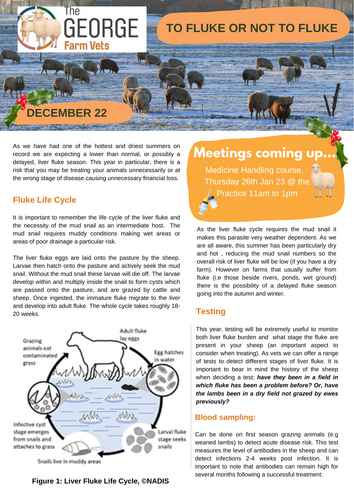News
READ THE FULL NEWSLETTER HERE - please click
 As we have had one of the hottest and driest summers on record we are expecting a lower than normal, or possibly a delayed, liver fluke season. This year in particular, there is a risk that you may be treating your animals unnecessarily or at the wrong stage of disease causing unnecessary financial loss.
As we have had one of the hottest and driest summers on record we are expecting a lower than normal, or possibly a delayed, liver fluke season. This year in particular, there is a risk that you may be treating your animals unnecessarily or at the wrong stage of disease causing unnecessary financial loss.
Fluke Life Cycle
It is important to remember the life cycle of the liver fluke and the necessity of the mud snail as an intermediate host. The mud snail requires muddy conditions making wet areas or areas of poor drainage a particular risk.
The liver fluke eggs are laid onto the pasture by the sheep. Larvae then hatch onto the pasture and actively seek the mud snail. Without the mud snail these larvae will die off. The larvae develop within and multiply inside the snail to form cysts which are passed onto the pasture, and are grazed by cattle and sheep. Once ingested, the immature fluke migrate to the liver and develop into adult fluke. The whole cycle takes roughly 18-20 weeks.
As the liver fluke cycle requires the mud snail it makes this parasite very weather dependent. As we are all aware, this summer has been particularly dry and hot , reducing the mud snail numbers so the overall risk of liver fluke will be low (if you have a dry farm). However on farms that usually suffer from fluke (i.e those beside rivers, ponds, wet ground) there is the possibility of a delayed fluke season going into the autumn and winter.


